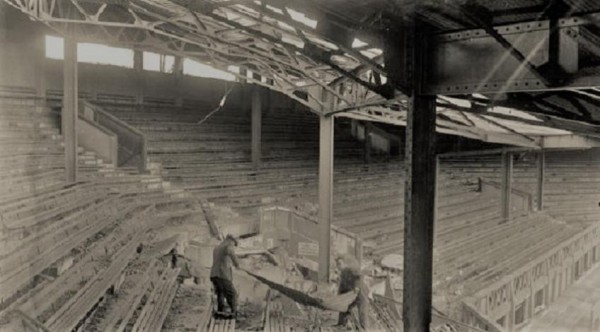By Randy Walker
@TennisPublisher
For the first time since 1945, The Championships at Wimbledon will not be played. The global coronavirus pandemic caused the All England Club to cancel the tournament for 2020.
Wimbledon is the oldest tennis tournament in the world, starting in 1877, and was only not played due to World I from 1915 to 1918 and from 1940 through 1945 due to World War II.
As documented in my book “On This Day In Tennis History” (for sale and download here: https://www.amazon.com/dp/0942257421/ref=cm_sw_r_tw_dp_U_x_S0nHEbPXKGW6J), it was on October 11, 1940 when bombs first hit Centre Court during the Battle of Britain. “Bombs cause significant damage to a section of the stadium, blowing a hole in the Centre Court roof and destroying 1,200 seats,” I wrote. During the war, the club was used as a civil defense center as well as farmyard with pigs, hens, geese and rabbits. The parking lots were tilled and used a “Victory Gardens.”
In 1946, a year after the war ended, there was some doubt as to whether the All England Club would be ready to host the event. In his definitive book “The Bud Collins History of Book” (for sale and download here: https://www.amazon.com/dp/1937559386/ref=cm_sw_r_tw_dp_U_x_YhoHEb5HQTRHA), Hall of Fame tennis journalist Bud Collins wrote of the uncertain resumption of The Championships in 1946.
“There had been some reluctance on the part of the All England Lawn Tennis & Croquet Club to stage the Championships at all in 1946,” Collins wrote. “The club had been heavily damaged by German bombs, and a gaping hole in the Centre Court competitors’ stand and adjacent seats had co be cordoned off. The organizing committee did not want to have a tournament if Wimbledon’s prewar standards of preeminence could not be maintained. Colonel Duncan Macaulay, who returned as the club’s full-time secretary after the war, summarized the obstacles in his book Behind the Scenes at Wimbledon: ‘The groundsmen were not back from the war, the mowers wouldn’t work, the rollers wouldn’t roll, nothing would function. We were surrounded by bomb-shelters, improvised buildings and huts of every sort. The back part of the club was covered with broken glass as a result of flying bombs. Britain was under a right wartime economy and nothing could be obtained without a license or a coupon. There was the difficulty of supplies of balls and rackets and the printing of tickets. Paper was very short. Soap, too, was strictly rationed. Clothes were rationed and tennis flannels and costumes were almost non-existent. And of course, food was rationed, too— and there would be hungry thousands to be fed each day. The club’s ration of whiskey was one bottle a month!’” Nevertheless, with customary efficiency and industry, the Championships was staged and again established as a showcase of the tennis world.”
Collins also wrote in “The Bud Collins History of Tennis” of the state of the French Championships during the World War II, writing, “Stade Roland Garros had a shameful wartime chapter as a concentration camp, first run by a frantically insecure French government to intern political dissidents, aliens and other suspect types. Later, with the German occupation, it housed Jews who would be shipped east to their doom. Not up to Nazi standards, Roland Garros was returned to the French Federation in 1941. Regardless of an acute shortage of balls and rackets, national tournaments of sorts were held through 1945. Yvon Petra, recovered from his wounds after a stint as a POW, won the men’s titles in 1943-44-45, and stayed fit for his successful shot at the first post-war Wimbledon title. In 1943, he beat a re-appeared 41-year-old Musketeer, Henri Cochet, in the final. A friend, ex-French Davis Cupper Robert Abdesselam, says that four-time champ Cochet ‘felt it important to play during the war, to show himself so that our dispirited youth would know that a Frenchman had been a world champion.’ Philippe Chatrier, later head of the French Federation and the ITF, an exceptional administrator named to the International Tennis Hall of Fame, was a young player growing up during the war. He remembered a few cans of new balls – something he and his friends had never seen – arriving at Roland Garros through the Red Cross, a gift from the USLTA. ‘What a wonderful country America must be to do that,’ he thought.”
The Australian Championships was also not played during World War II, after the 1940 event, but the U.S. Championships continued to be played, although with reduced fields of mostly American players.
In the current coronavirus pandemic situation, the indoor tennis courts at the Billie Jean King USTA National Tennis Center, the site of the U.S. Open, is being used as a temporary hospital and Louis Armstrong Stadium, the facility’s No. 2 show court, is being used as a commissary to feed patients and medical personnel.

